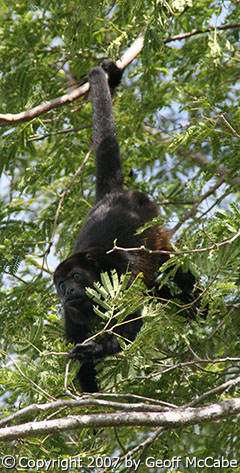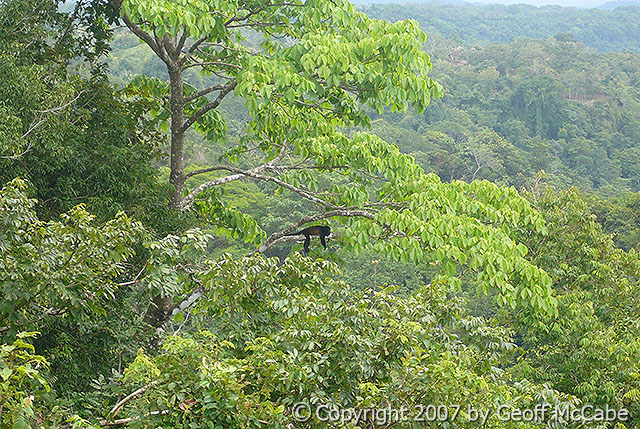Costa Rica Monkeys
White Capuchin Monkeys
Capuchin monkeys, also called white-faced monkeys, occupy the wet lowland forests on Caribbean coast of Costa Rica and Panama and deciduous dry forest on the Pacific coast along with other wild animals in the jungles here. They are indigenous to Central and South America and can be regularly seen in many of Costa Rica’s national parks. Capuchins have small, slender bodies covered in brown or black fur. Their faces, necks and chests are typically white or cream colored that has led to them being christened the white-faced monkeys.
These White capuchin monkeys are rather distinguishable in appearance from other Central American primates. They feature a black body with white upper chest and shoulders, and a stark pale face with a black cap on their skull. They are diurnal and arboreal by nature, and can regularly be seen utilizing their prehensile tails and powerful limbs to sway between trees. The average group size is about 15 per group, with an adult alpha male leading the troop. Females have one baby every 1 to 2 years, who is cared for by the mother for the first 5 or 6 months of its life.
Capuchins are said to have one of the most varied diets of New World monkeys. Aside from resting, all their time is spent moving about and foraging, starting at daybreak and traveling about until night. They forage from the forest floor to the canopy, and their troop can spread really far for the purpose of foraging. They will also make the journey to spring or other sources when they are thirsty. Their actions are known to have a deep impact on the vegetative populations in their habitats. They may do this by dispersing seeds of some species, stimulating branching by their pruning activities, and devouring insects that would otherwise destroy plants.
The diet of Capuchins are primarily insectivorous, but have a diet broad beyond insects – fruits, flowers, invertebrates, as well as the less frequent bird eggs, bird hatchlings, nestling squirrels, and small lizards. They will eat plant material some times as well. The insects they consume include butterfly larvae, ants, cicadas, grasshoppers, and others. These omnivores are highly discerning about their food. They prefer eating ripe fruits, swallowing the juice and flesh, and spitting out the unwanted parts.
Spider Monkeys
The spider monkey species formerly was earlier abundantly spotted all over Costa Rica and was prevalent in several parts of Central America. Off late, owing to poaching and deforestation, it is limited to regions with jungle belts big enough to hold its large troops. Since Spider Monkeys are one of the largest New World primate species, they have become more susceptible to hunting. Spider monkeys tend to stay high off the ground in the canopy of tropical forests. This species contains 9 subspecies based on their color. The color of the back, shoulders, and tail ranges from blonde to black based on the subspecies. Costa Rica is home to a couple of these subspecies. Spiders are the most agile of the Costa Rican monkeys. They prance through trees utilizing their forelimbs and tail. The Spider’s legs are long and slender, and they possess the most prehensile tails of all Costa Rican primates that supports their entire weight.
Spider Monkeys utilize their tails like a fifth limb with which they can manage their entire weight. They are rarely known to leave the place they primarily inhabit, and feed constantly on foliage, nuts and fruits. They communicate with each other through gestures. Beware, they are known to scare off humans who try to intrude into their habitat by shaking branches heartily to scare the trespasser away. If even this turns out to be ineffective, they vociferously hurl huge branches at the prowler.
The Spider Monkey’s group dynamics are known to be highly complicated and can fluctuate several times through the day. They tend to subdivide into small groups, often into clans of 2 to 3 individuals, and also mini troops within the troop with an adult male, a few adult females and their young. During the end of the day, the subgroups meet up as a single unit that comprises many adult males, juvenile males, adult females and their babies. Their total group size is approximately 20 individuals. Other than coming together into the big group at certain trees, spider monkeys also forage independently or in their tinier groups. These primate species almost exclusively feed on fruits, but sometimes they will supplement their fruit diet with nascent leaves for more protein.
Mantled Howler Monkeys
Howlers live in the elevated forest canopies of lowland and montane forests. In Costa Rica, they are found at the La Selva, Corcovado National Park, Santa Rosa National Park, Monteverde Cloud Forest Reserve; may also be found in San Jose and San Vito. Howlers are famous for the cacophonous vocalizations produced by adult males. Their howls can be heard up to a couple of kilometers away through the forest. They often make these calls at sunrise or in reply to other sounds such as airplanes and thunder, or other howlers. Some biologists have found out that their howling is nothing but a means to communicate within the troop. An adult male howler weighs up to 6 to 7 kg; an adult female about 4 to 5 kg. Howlers have prehensile tails longer than their body length. At birth, the infant howlers weigh about 0.4 kg.
The Mantled Howler Monkey is indigenous to Colombia, Costa Rica, Ecuador, Honduras, Guatemala, Mexico, Nicaragua and Panama. The Mantled Howler Monkey is synonymous with Costa Rica’s wildlife and is among the most frequently spotted primates in several Central American national parks, including Manuel Antonio, Corcovado National Park, Monteverde Cloud Forest Reserve and Santa Rosa National Park. They are generally found on the shelters of the low land and mountainous regions of Costa Rica, though it is common to see them everywhere including when you’re enjoying an outdoor breakfast at your chic vacation resort. Mantled howler monkeys are omnipresent in Costa Rica.
Mantled Howler females gain ripe sexuality at 3 years.
They pass through a regular estrus cycle for 16 days, and they exhibit skin transformation, generally related to swelling of the skin and a change in the labia minora color from white to light pink. A female mantled howler monkey generally indulges in multiple mating before conception. The age of sexual maturity for howler males is about 40 months, but the mating process for males trying to breed in non-maternal groups may be prolonged until they elevate themselves to the required social status. In some places, they will act as your wake up call. Despite being notorious for their cacophonous cries, howlers are known to be surprisingly quietly and movers. They are known to rest for a major part of the day.
The Mantled Howler Monkey group usually comprises several adult males and females, with their juveniles and infants, although juveniles usually leave their parents’ group eventually. At 12 weeks, howlers are known to move away from their parents. A female will become sexually active at 3 years, and have her first infant before her fourth year, with a gestation period of 6 months. The adult males are known to dominate the group but the youngest adult of either sex holds the much coveted alpha rank for that sex. The Howler Monkey’s average group size varies from 11 to 18 depending on the region. They are almost never spotted on the group and stay put on the canopies. Howlers are relatively common within the Costa Rican forest canopies, hotels, eco resorts and national parks.
Squirrel
Squirrel monkeys make their homes in the tropical evergreen forests, mangroves, and secondary forests. In Costa Rica, the squirrel monkey is spotted only in the Pacific lowlands and southern part of Costa Rica. Some are as small as 5-6 monkeys per group, while others as large as several dozen (at a times a hundred monkeys per groups). Several adult males join a single troop, and there are normally four adult females for every male in a group. Females give birth to single babies at a time after a 5-6 month gestation period.
Tourism and farming have collectively contributed to drastically affecting Costa Rica’s depleting population of squirrel monkeys. How they managed to get Costa Rica and breed and live in isolation from their band, the closest of which is hundreds of miles away is still not fathomed by biologists. This isolation, though, has turned them into vulnerable and destructive creatures, and in recent decades their numbers have plunged significantly.
All of Costa Rica’s squirrel monkeys are part of the endangered lot, but their subspecies found near the Manuel Antonio is virtually extinct. There are less than a thousand of them left in Costa Rica now when some decades ago the number was three to four times more than that. Deforestation, habitat destruction and their isolation have all played a part in the near extinction of these intriguing species.
Further Reading
http://www.costaricajourneys.com/mantled-howler-monkey/
http://www.montezumabeach.com/howler-monkeys/
http://www.montezumabeach.com/white-faced-capuchin-monkey/
http://www.costaricajourneys.com/spider-monkey/



















